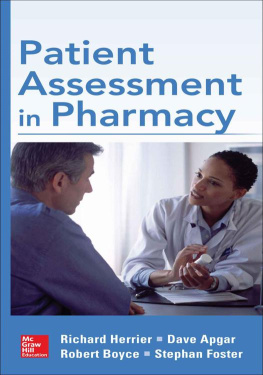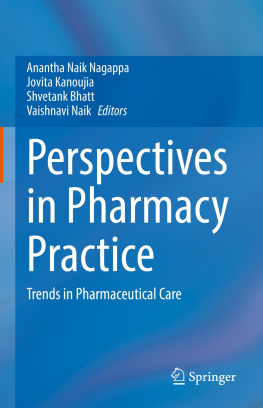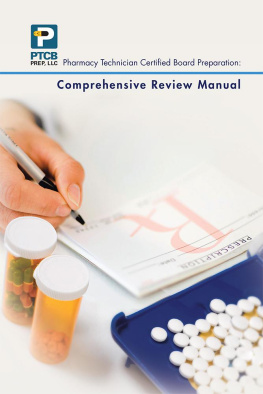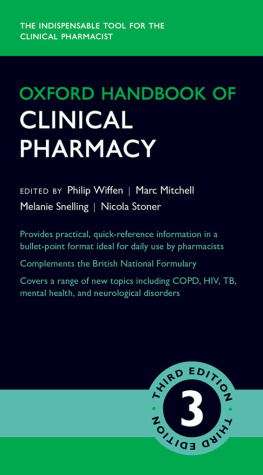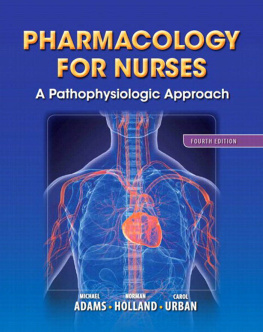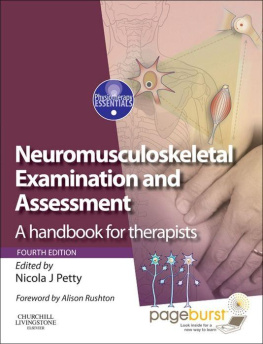NOTICE
Medicine is an ever-changing science. As new research and clinical experience broaden our knowledge, changes in diagnosis, treatment and drug therapy are required. The authors and the publishers of this work have checked with sources believed to be reliable in their efforts to provide information that is complete and generally in accord with the standards accepted at the time of publication. However, in view of the possibility of human error and changes in medical sciences, neither the authors nor the publisher nor any other party who has been involved in the preparation or publication of this work warrants that the information contained herein is in every aspect accurate or complete and they disclaim all responsibility for any errors or omissions or for the results obtained from the use of information contained in this work. Readers are encouraged to confirm the information contained herein with other sources.

Copyright 2015 by McGraw-Hill Education. All rights reserved. Except as permitted under the United States Copyright Act of 1976, no part of this publication may be reproduced or distributed in any form or by any means, or stored in a database or retrieval system, without the prior written permission of the publisher.
ISBN: 978-0-07-182116-2
MHID: 0-07-182116-3
The material in this eBook also appears in the print version of this title: ISBN: 978-0-07-175194-0, MHID: 0-07-175194-7.
eBook conversion by codeMantra
Version 1.0
All trademarks are trademarks of their respective owners. Rather than put a trademark symbol after every occurrence of a trademarked name, we use names in an editorial fashion only, and to the benefit of the trademark owner, with no intention of infringement of the trademark. Where such designations appear in this book, they have been printed with initial caps.
McGraw-Hill Education eBooks are available at special quantity discounts to use as premiums and sales promotions or for use in corporate training programs. To contact a representative, please visit the Contact Us page at www.mhprofessional.com.
TERMS OF USE
This is a copyrighted work and McGraw-Hill Education and its licensors reserve all rights in and to the work. Use of this work is subject to these terms. Except as permitted under the Copyright Act of 1976 and the right to store and retrieve one copy of the work, you may not decompile, disassemble, reverse engineer, reproduce, modify, create derivative works based upon, transmit, distribute, disseminate, sell, publish or sublicense the work or any part of it without McGraw-Hill Educations prior consent. You may use the work for your own noncommercial and personal use; any other use of the work is strictly prohibited. Your right to use the work may be terminated if you fail to comply with these terms.
THE WORK IS PROVIDED AS IS. MCGRAW-HILL EDUCATION AND ITS LICENSORS MAKE NO GUARANTEES OR WARRANTIES AS TO THE ACCURACY, ADEQUACY OR COMPLETENESS OF OR RESULTS TO BE OBTAINED FROM USING THE WORK, INCLUDING ANY INFORMATION THAT CAN BE ACCESSED THROUGH THE WORK VIA HYPERLINK OR OTHERWISE, AND EXPRESSLY DISCLAIM ANY WARRANTY, EXPRESS OR IMPLIED, INCLUDING BUT NOT LIMITED TO IMPLIED WARRANTIES OF MERCHANTABILITY OR FITNESS FOR A PARTICULAR PURPOSE. McGraw-Hill Education and its licensors do not warrant or guarantee that the functions contained in the work will meet your requirements or that its operation will be uninterrupted or error free. Neither McGraw-Hill Education nor its licensors shall be liable to you or anyone else for any inaccuracy, error or omission, regardless of cause, in the work or for any damages resulting therefrom. McGraw-Hill Education has no responsibility for the content of any information accessed through the work. Under no circumstances shall McGraw-Hill Education and/or its licensors be liable for any indirect, incidental, special, punitive, consequential or similar damages that result from the use of or inability to use the work, even if any of them has been advised of the possibility of such damages. This limitation of liability shall apply to any claim or cause whatsoever whether such claim or cause arises in contract, tort or otherwise.

This textbook is dedicated to those Indian Health Service (IHS) pharmacists and other health professionals who from the 1960s through the 1970s pioneered the development of the first pharmacy practice model that focused on the PATIENT rather than on the dispensing process. These patient-centered practice innovations included (1) verifying patient understanding on proper use of prescription medications through patient counseling in private consultation rooms; (2) review of prescription orders for appropriateness; and (3) rectifying problems prior to dispensing; and (4) using pharmacists as primary care providers with prescriptive authority. This pharmacist-based management of patients with common chronic diseases and the diagnosis and treatment of common minor acute illnesses was supported by the IHS Pharmacist Practitioner Training Program (IHS PPTP). This program, initiated as an HRSA grant-funded program in 1973, expanded to an IHS-wide program in 1976. The principles of the training for the IHS PPTP serve as the foundation for this textbook. Successor to the IHS PPTP, the IHS Clinical Pharmacy Training Program (IHS CPTP) provided postgraduate training to enable pharmacists to practice in this unique patient-centered pharmacy practice model. All of these patient-centered pharmacy practice innovations were made possible by the farsighted leadership of Admiral Allen J Brands, who directed the pharmacy programs of the Indian Health Service and the U.S. Public Health Service. His dedication and persistence in developing and sharing these innovations with the pharmacy profession eventually became the basis for todays ambulatory clinical pharmacy practice.

CONTENTS
PART ONE
PRINCIPLES OF PATIENT ASSESSMENT
Approach to Differential
Diagnosis
PART TWO
ASSESSMENT OF SYMPTOMS
Heartburn and
Abdominal Pain
PART THREE
ASSESSMENT IN THE DIAGNOSIS AND MANAGEMENT OF CHRONIC DISEASES AND THEIR COMPLICATIONS
PART FOUR
ASSESSMENT OF POTENTIAL DRUG-RELATED PROBLEMS

PREFACE
This textbook is intended to fill the significant resource gaps in patient assessment needed by pharmacists to provide optimal patient-centered pharmacy services including primary care. Existing pharmacy materials do not include the necessary breadth and depth in these areas. This textbook is intended to help pharmacists integrate the pathophysiology, findings from history taking, physical examination, and laboratory test interpretation to make accurate assessments in two areas. The first helps the pharmacist make a more accurate diagnosis and thus enables them to better advise patients regarding appropriate use of products intended for self-care or accurately refer patients to higher levels of care if indicated. The second area is to enhance the pharmacists ability to assist patients in the management of their chronic diseases, outlining monitoring parameters for disease control, early detection of disease-based complications, and drug therapybased adverse effects. In addition, the textbook will enhance pharmacists ability to counsel patients about both prescription and nonprescription medications, enhance their ability to communicate with other health care professionals, and assist in identification of potential drug-related problems.

